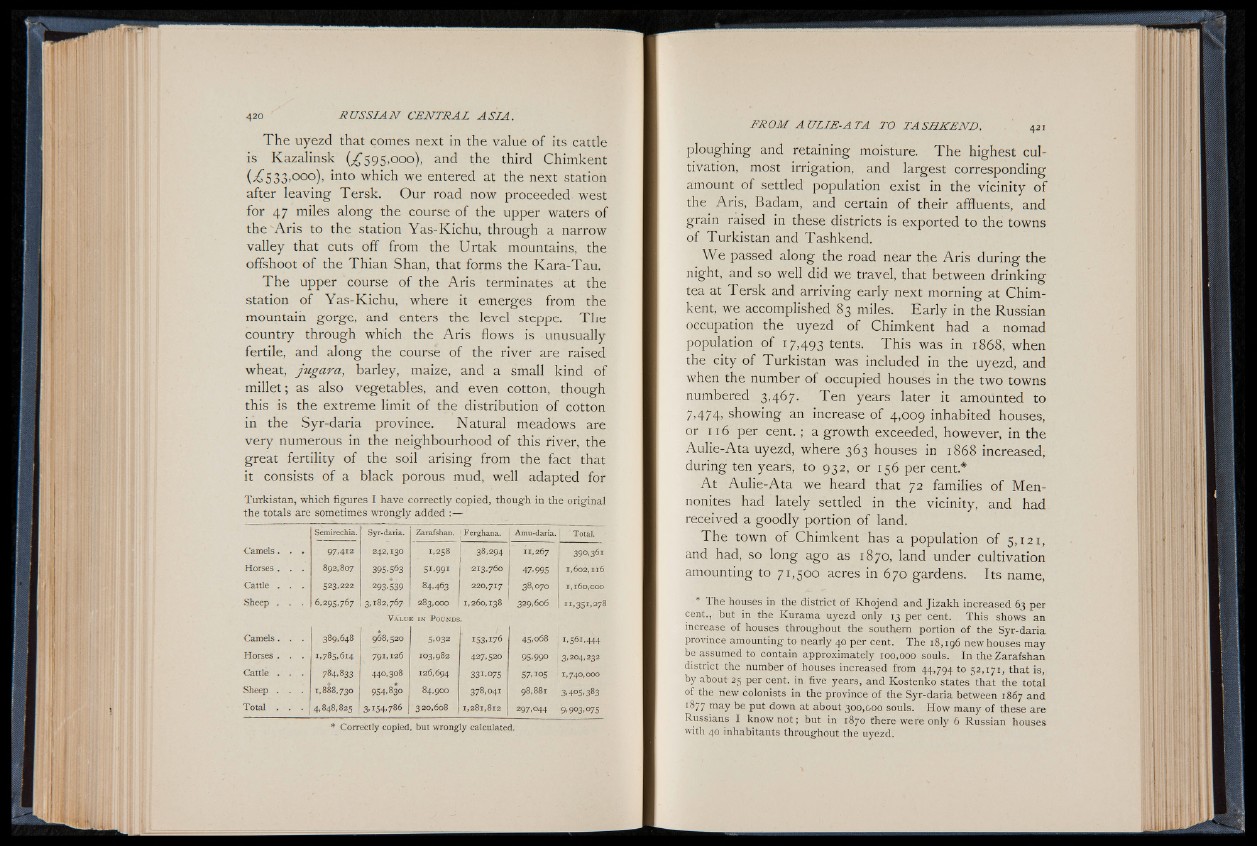
The uyezd that comes next in the value of its cattle
is Kazalinsk (£595,000), and the third Chimkent
(^533>°°°)> into which we entered at the next station
after leaving Tersk. Our road now proceeded west
for 47 miles along the course of the upper waters of
the Aris to the station Yas-Kichu, through a narrow
valley that cuts off from the Urtak mountains, the
offshoot of the Thian Shan, that forms the Kara-Tau.
The upper course of the Aris terminates at the
station of Yas-Kichu, where it emerges from the
mountain gorge, and enters the level steppe. The
country through which the Aris flows is unusually
fertile, and along the course of the river are raised
wheat, jugara, barley, maize, and a small kind of
millet; as also vegetables, and even cotton, though
this is the extreme limit of the distribution of cotton
in the Syr-daria province. Natural meadows are
very numerous in the neighbourhood of this river, the
great fertility of the soil arising from the fact that
it consists of a black porous mud, well adapted for
Turkistan, which figures I have correctly copied, though in the original
the totals are sometimes wrongly added :■—
Semirechia. Syr-daria. Zarafshan. Ferghana. Amu-daria. Total.
Camels. . . 9 7 ,4 12 242,130 1,258 38,294 11 ,2 6 7 390,361
Horses . . . 892,807 395.563 5 1 .9 9 1 213,760 47.995 1 ,60 2 ,1 16
Cattle . . . 523,222 293.539 84,463 220,717 38,070 1,160,000
Sheep . . . 6,295,767 3 ,182 ,7 6 7 283,000
.
p 260,138 329,606 1 1 ,3 5 1 ,2 7 8
V a l u e i n P o u n d s .
Camels. . . 389,648 968,520 5.032 15 3 ,176 45,068 1,56 1 ,4 4 4
Horses . . . 1,78 5 ,6 14 7 9 1 ,12 6 103,982 427,520 95 ,99° 3,204,232
Cattle , . . 784.833 440,308 126,694 s a w s S7, i °5 1,740,000
Sheep . . . 1,888,730 954.830 84,900 378,041 98,88l 3,40S ,383
Total . . . 4,848,825 3,154,786 320,608 I,28l ,8l 2 297,044 9 , 903,075
* Correctly copied, but wrongly calculated.
ploughing and retaining moisture. The highest cultivation,
most irrigation, and largest corresponding
amount of settled population exist in the vicinity of
the Aris, Badam, and certain of their affluents, and
grain raised in these districts is exported to the towns
of Turkistan and Tashkend.
We passed along the road near the Aris during the
night, and so well did we travel, that between drinking
tea at Tersk and arriving early next morning at Chimkent,
we accomplished 83 miles. Early in the Russian
occupation the uyezd of Chimkent had a nomad
population of 17,493 tents. This was in 1868, when
the city of Turkistan was included in the uyezd, and
when the number of occupied houses in the two towns
numbered 3,467. Ten years later it amounted to
7,474, showing an increase of 4,009 inhabited houses,
or 116 per cent. ; a growth exceeded, however, in the
Aulie-Ata uyezd, where 363 houses in 1868 increased,
during ten years, to 932, or 156 per cent.*
A t Aulie-Ata we heard that 72 families of Men-
nonites had lately settled in the vicinity, and had
received a goodly portion of land.
The town of Chimkent has a population of 5,121,
and had, so long ago as 1870, land under cultivation
amounting to 71,500 acres in 670 gardens. Its name,
* The houses in the district of Khojend and Jizakh increased 63 per
cent., hut in the Kurama uyezd only 13 per cent. This shows an
increase of houses throughout the southern portion of the Syr-daria
province amounting to nearly 40 per cent. The 18,196 new houses may
be assumed to contain approximately 100,000 souls. In the Zarafshan
district the number of houses increased from 44,794 to 52,171, that is,
by about 25 per cent, in five years, and Kostenko states that the total
of the new colonists in the province of the Syr-daria between 1807 and
1877 may be put down at about 300,000 souls. How many of these are
Russians I know not; but in 1870 there were only 6 Russian houses
with 40 inhabitants throughout the uyezd.